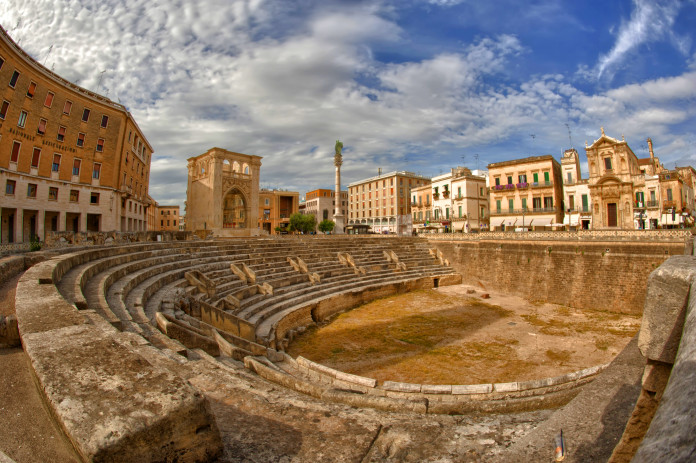
Lecce is both a summer tourist destination and a city of art. It is full of masterpieces of Roman, Medieval and Renaissance age, but above all, Lecce is a Baroque city. Here the baroque is expressed in an unique way. Decorations enrich the buildings with strong colors of the “pietra leccese” (Lecce’s stone): soft and compact calcareous stone, with white/gold colors. The baroque style spread in Lecce during the Spanish domination, substituting the classical art and creating a style which left more space to the imagination of the artists. In the city centre you can admire beautiful examples of the stonework in monumental churches, balconies and terraces. Cozy, organized and near the sea, Lecce is a must see place in Italy. Below we suggest you 10 things you can’t miss Lecce.
If you are looking for a hotel in Lecce, we suggest you to choose among those offered by Booking.com. There are about 700 hotels with prices, pictures and comments of guests already stayed there. Go to Booking.com
The old town centre of Lecce
1
Lecce is also called “The baroque lady”. The baroque style characterizes spires, portals, churches, monuments and houses of the “centro storico”, the old town centre .
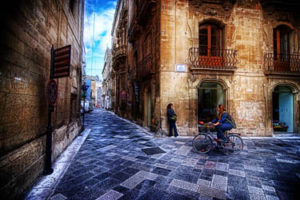
Walking through Porta Napoli, built in 1548 in honor of Charles V, you’ll enter in the old town. Here starts the main streets where you can admire refined buildings and workshops. In the city centre you can visit the church Chiesa di Santa Maria della Provvidenza, in Baglivi square, and the church of Santa Maria di Costantinopoli, in Addolorata square. In Via Umberto I, you’ll see Adorno Palace and the Basilica of Santa Croce, symbol of the city and of the Baroque art.
Then you can have a walk in Sant’Oronzo square, heart of the city life, where rises the beautiful column dedicated to the Saint Patron. You can’t miss the Cathedral square, with the splendid façade of the Cathedral and its tall bell tower. Moreover there’s the XV century palace of the Bishop with an angular arched loggia, the palace of the Seminary built in 1700, now seat of the Diocesan Museum of Sacred Art, the Innocenziana Library and Diocesan Historical Archive.
For lovers of gardens, the Villa Comunale, situated near Sant’Oronzo Square, will be a pleasant stop. It was named after Giuseppe Garibaldi and once it was called “Villa della Lupa” for the presence of a cage in which some wolf were held (the wolf stands in the emblem of the city called by the Romans “Lupiae” )
The Roman Amphitheatre in Lecce
2
This is the most relevant testimony of the Roman age. It was built in the II century AD to entertain the viewers with shows and games (it could hosts about 20.000 people).
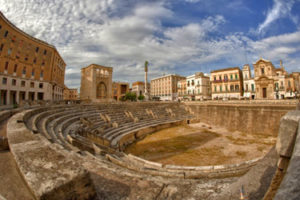
The monument was completely buried by rubble because of earthquakes, and only at the beginning of the XX century it was brought back to the surface. The part of the monument which is visible today it’s just one third of its original size, the remainder is probably still under the central Sant’Oronzo square. The amphitheatre structure was built with tuff columns surmounted by arcades. Some statues were found in this structure, a statue of Athena (nowadays at the Castromediano’s Museum) and some marble relieves on the railings. The scenes, represented on these marble relieves, illustrates hunting scenes and fights between mans and animals. Nowadays the Amphitheatre is the location of concerts and events
Where: St. Oronzo square
How to get there: by feet
When – Hours: It’s possible to visit the Roman Amphitheatre (except on days when performances are scheduled) by reservation at the Info Point Castle of Charles V (+39 0832.246517 – castellocarlov@gmail.com).
Tickets: full price € 2.00; reduced rates reserved for groups composed of more than 10 people: € 1.00. Service guided tour: € 1.00 extra on the ticket price.
Castle of Charles V in Lecce
3
The Castle was built in 1539 by Carlo V and is placed near St Oronzo square. The project of the building was made by the architect Gian Giacomo dell’Acaya and two constructions were pulled down in order to build this fortress: Cappella di Santa Trinità and Monastero Celestino di Santa Croce. The Castle has two concentric structures separated by an intermediate court, four corner bastions (S. Giacomo, S. Croce, S. Trinità and S. Martino) and great walls
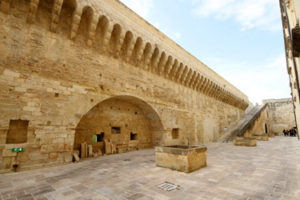
For long time the castle had a defensive functions, but in the XVIII century one of its rooms was used as theatre. From the 1870 to the 1979 it was used as military district. Nowadays it’s the seat of the Cultural Department of the township of Lecce, and it’s used for all the cultural initiatives. On the first floor there’s the big room (Duchess Hall) with cross vault and Gothic capitals with leaf decorations and allegorical illustrations.
Where: viale XXV luglio, near St Oronzo square
How to get there: by feet
When – Hours:
Winter: Monday – Friday 9:00 am to 8:30 pm , Sat. and Sun. 9:30 am to 8:30 pm ;
Summer: from 1/06 to 15/07 and 1/09 to 30/09 from Mon. the Fri. 9:00 am to 9:00 pm Sat, Sun and holidays 9:30 am to 9:00 pm ; from 16/07 to 31/08 from Mon. the Fri. 9:00 am to 11:00 pm , Sat, Sun and holidays 9:30 am to 11:00 pm
Tickets: € 3.00; reduced € 2.00; Children (6-12 years) € 1.00
St Oronzo square in Lecce
4
St. Oronzo square is the main square of Lecce. It’s the public living room where people use to meet and it has a mosaic pavement representing the emblem of the city: the wolf under a holm oak tree and the crown with five towers.
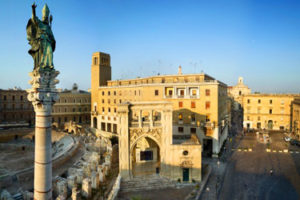
The buildings, built between Middle age and XIX century, have different styles but they coexist in a harmonious way. In the past it was known as the “Square of Merchants” for its large number of shops and commercial activities but then they disappeared to build the headquarters of the Bank of Italy (XX century).
From 1656 the square is dedicated to the Saint Patron of the city. The legend tells that during plague Lecce was spared thanks to the saint, so people of Lecce erected the votive column of the saint. St Oronzo column represents just one of the attractive of the square where you can visit also the Roman Amphitheatre. In the square there are also Palazzo del Seggio (1592), the ancient church of San Marco, and the church Santa Maria della Grazia, which was built in 1590 after the discovery of a painting representing the Virgin with the baby.
The Cathedral of Lecce
5
The Cathedral of Lecce is placed in Piazza Duomo and it’s the fulcrum of the religious city life. The Cathedral is dedicated to Maria SS. Assunta and it was first built in 1144, renovated in 1230, and rebuilt in 1659 by Giuseppe Zimbalo thanks to the bishop Luigi Pappacoda.
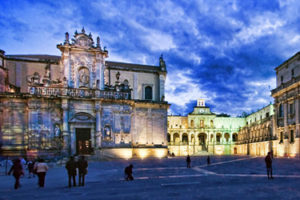
The Cathedral has two entrances, the principal façade is sober and elegant with some statues of St Gennaro and Ludovico, while the second entrance is a masterpiece of Baroque art with a statue representing St. Oronzo and St. Giusto and St. Fortunato. The interior space has a nave and two aisles, separated by columns and semi columns. The central nave and the transept have wood roof in which there are mounted some paintings representing the Martyr of St. Oronzo and the Last supper. This Cathedral has twelve altars.
the highest pointof art history and it’s painted on the vaulted ceiling of the Cappella Brancacci (chapel) in Florence, in the Church of Santa Maria del Carmine. Masolino and Masaccio, young and old, teacher and pupil, frescoed this chapel together, which was commissioned by Felice Brancacci. Brancacci obliged the two guys to work on the same walls to reduce the style differences at the minimum. It ‘s a masterpiece that surprises everyone, believers or not , telling the sin’s history and other episodes of the Bible and Gospel.
Where: Piazza Duomo
How to get there: by feet
When – Hours: Every day 7.30 am – 12 pm and 3.30 – 6 pm; summer 8 am – 12.30 pm and 4 – 8 pm
Tickets : free entrance
Basilica di Santa Croce in Lecce
6
The Basilica with the Celestine Convent (now the Government Palace) is one of the biggest architectural complexes of the city. It’s also the most significant example of Lecce’s Baroque, especially for the opulence of the main façade decorations.
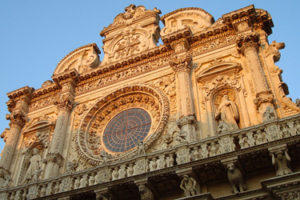
Between the XVI and XVII centuries, the greatest architects of Salento – Riccardi, Penna and Zimbalo – realized the great work commissioned by the Celestini’s religious order. The result was great: a magnificent monument made of Renaissance and Baroque elements. The façade of the Basilica consists of three parts.
The lower part, in Renaissance style, is divided by six columns supporting a structure richly decorated with lions and women. On the side doors there are the emblems of the Celestine’s order and the Holy Cross, while on the main entrance, with two pairs of columns, there is the emblem of Philip III of Spain.
The second part of the façade is dominated by a beautiful central rose window of Romanesque inspiration and two niches with statues of St. Benedict and St. Celestine. There are also two female statues symbolizing the Faith and Fortitude. On the top, the gable with the Cross.
The interior is divided into three naves separated by high columns and it’s sumptuous too. The nave has a wooden paneled ceiling while the aisles have vaulted ceilings and seven chapels on each side. The precious chapel of San Francesco da Paola has the altar with six columns made by Zimbalo (1614-15) decorated with 12 panels depicting episodes from the life of the saint. It’s considered one of the highest sculptural expressions of Lecce’s Baroque
Where: Via Umberto I
How to get there: by feet
When – Hours: Every day 9-12 am and 5-7 pm during the winter, until 8 pm during the summer
Tickets: free entrance
Lecce's churches
7
There’s plenty of churches in Lecce: the Cathedral, the Basilica of Santa Croce and many other churches in the streets and in the squares of the city (about 40)

Among these, we suggest you to visit Church of St. Nicolò and Cataldo: it was built in the Middle Age (1180) and then restructured in 1716 with a Baroque appearance but preserving elements of its original style.
The portal is decorated with arabesques and floral themes while the interior has a Latin cross shape with three tall and narrow aisles. Among the most original churches, you should admire the Church of St. Matthew (1667 – 1700), with its unique curved façade. The building has a Baroque façade while the interior has an elliptical shape and arched chapels containing rich altars decorations. The church of Saint Irene is beautiful too. It was built in the ‘500 by the order of the Theatine and it has on the main portal the statue of the saint and, on the high pediment, the emblem of the city (the wolf under the crowned holm oak ). The interior has a nave with three chapels on each side; the altar is dedicated to St. Irene and behind the high altar there is the painting of the Madonna della Libera. All the churches of Lecce, with medieval, Renaissance and Baroque style, preserve the historical, artistic and religious heritage of the city.
Abbazia di Santa Maria di Cerrate in Lecce
8
The Abbey is a little jewel located on the road that connects Squinzano to Casalabate. It is a magnificent example of Romanesque architecture of Salento.
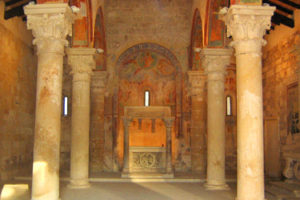
According to the legend, the abbey was built around the XII century by Tancredi d’Altavilla in the place where he had a vision: the Virgin between the horns of a deer (hence the name Cervate then Cerrate). Important religious center until the ‘500, the building was later sacked (1711) and left in a state of disrepair until it was restored in 1965.
The façade has a small central rose window, a single lancet window on each side and an elegant portal . Next to the church you can admire a XIII century porch with cylindrical and polygonal columns and a Renaissance well.
The abbey’s interior is divided into three naves. Apses, and walls are adorned by frescoes of XIII and XIV century. Currently the abbey is one of the assets protected by the Fondo Ambiente Italiano
Where: Country road between Squinzano – Casalabate (SP100)
How to get there by car: Country road between Squinzano – Casalabate (SP100)
Where: Country road between Squinzano – Casalabate (SP100)
How to get there by car: Country road between Squinzano – Casalabate (SP100)
When – Hours: Saturdays and Sundays in July and August, hours 9.30 am 1 pm and 3 – 7 pm
For the other months, consult the FAI website
Tickets: Entrance with voluntary donations
Things to eat in Lecce
9
In Lecce you’ll find only good food: There are many typical dishes of Salento cuisine. The spices of the Mediterranean scrub (sage, mint, oregano, rosemary …) contribute, then, to enhance the flavor of any dish.
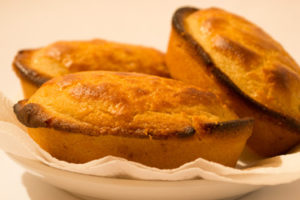
Vegetables and legumes are always available: they are usually cooked in a clay pot, seasoned with olive oil and served with Friselle (toasted bread and crackers). Among the typical dishes we have to mention the savory pie of Lecce, two discs of puff pastry stuffed with mozzarella, sauce, tomato, pepper and nutmeg; the “puccia”, wheat bread round in shape with black olives in the dough : be careful because the olives are not pitted! You have to taste also “municeddhe”, snails with a white membrane that recalls the color of the monk’s dress (mudiceddhe means precisely nuns). For dessert: in addition to the famous pasticciotto of Lecce, there is a big number of delicacies prepared with almond paste. What about wine? Negramaro, the Salice Salentino and Primitivo di Manduria are just some of Salento native wines which are distinguished by the color of body and flavor.
Where to sleep in Lecce
10
During the last years Lecce had a real tourist explosion, so the city nowadays has a great offer of hotels, B&Bs, agritourisms.
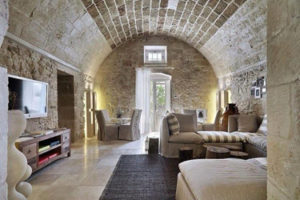
In the old town centre there are few luxury hotels, some 3 star hotels and above all, less expensive but very cozy, B&Bs. The prices are a little bit higher than those of the suburbs. An excellent alternative are the hamlets and agritourisms located just outside the town, near the sea or among the olive trees. They are renovated old farmhouses, many of them with swimming pool.
If you are looking for a hotel in Lecce, we suggest you to choose among those offered by Booking.com. There are about 2000 hotels with prices, pictures and comments of guests already stayed there. Go to Booking.com